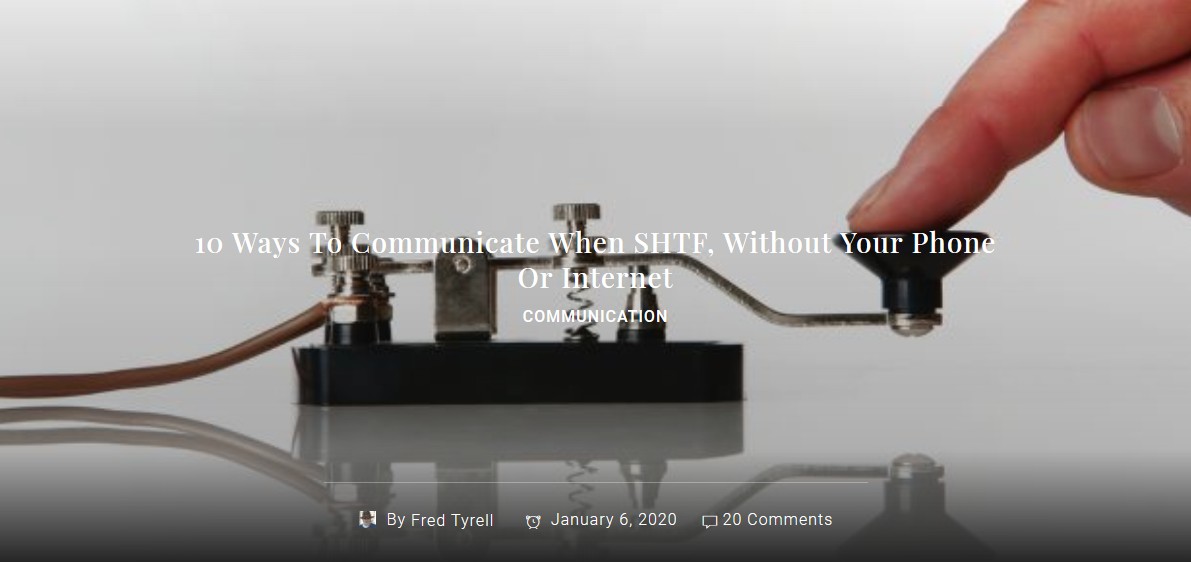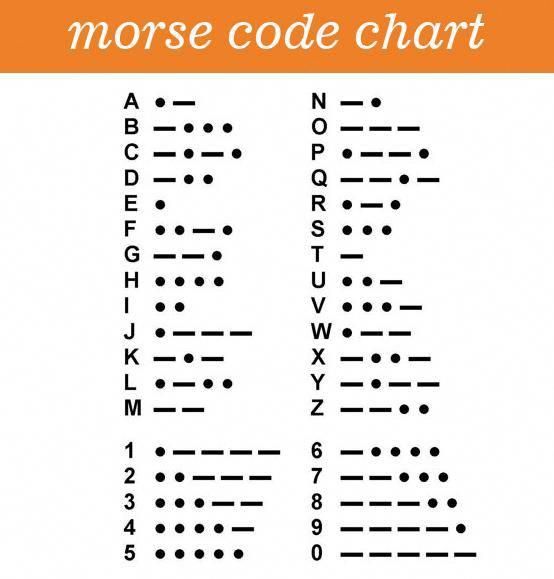 ☎ Old School Messaging from the Field of Master Mind Communications (MMCOMM) 📡
☎ Old School Messaging from the Field of Master Mind Communications (MMCOMM) 📡
Shared from the research of: Joseph Mercado 👨
Article Author: Fred Tyrell 👱
Content Contributor: Survivopedia 🔨
Blog Post #1042 📌
Re: Communicating without Your Phone or Internet 📻
Date and Time: Monday, October 19, 2020 at 1:03 p.m. ⏰
Dear Survivalist,
In a natural disaster, civil unrest, or other public emergency, being able to communicate up to 5 miles or more is very important.
When there isn’t a working cellphone system or the internet is unavailable, it can wreak havoc.
People that take their phone everywhere, or rely on it for all forms of contact with other people will be at a serious disadvantage.
Sadly, as we have seen already in some disasters, these individuals can and will mentally shut down or be unable to function at all.
While many people today take their cell phones and internet access for granted, there are other effective ways to communicate in an emergency.
Here are some older ways of communication that you should learn how to use.
Types Of Non-Cellular or Non-Web Radios and Phones:
Many people today think of radios only in terms of their capacity to receive signals.
While this is important for obtaining timely information in a crisis, there are other radios that you can use to transmit information to others that have a compatible receiver.
Ham Radios – This is the best radio to use for any type of post disaster communication.
Ham operators are regulated by the FCC, user must have a valid license.
These radios can be used to communicate with anyone around the world.
FEMA uses these radios to pass on vital information during emergencies and broadcast information to hospitals, shelters, police stations, fire stations and other emergence services.
CB Radios – Even though they aren’t as popular as the use to be, CB radios are still used by truckers and other commercial drivers.
The range of the radio depends on whether the transmitter is located in a base station or a mobile unit.
Base stations have a longer broadcasting range than mobile units.
CB radios must also be licensed by the FCC in order to operate. The average broadcasting distance is between 25 and 50 miles.
Walkie-Talkies – These are short ranged, hand held, battery powered radios that can be used for emergency communications.
Depending on the broadcasting power they may have a range of 1 to 10 miles.
Hand Cranked Radios with AM, FM, And Short Wave Channels – Although these radios can only receive, they are a big help in getting good reliable news and weather reports.
The nice thing about this radio is that it doesn’t need batteries.
It uses a crank generator to supply the needed electric power.
Satellite Phones – These phones work during disasters because they work through satellites instead of cellphone towers.
They will work without interruption unless the satellites are jammed.
They are expensive to buy and may not work in some situations that would not stop a Ham radio.
Land Line Phones – Most of these phones are obsolete by today’s standards.
There are still a few around in big cities and small towns.
If you can find a working phone in a disaster, they are much more reliable than cell phone networks.
Be sure to have some change, in case you find a pay phone.
In a major crisis, there may be times when you will not be able to transmit information using voice and words.
Instead, you may have to tap out sounds, or use a series of light flashes to communicate important information.
Here are two code systems that will be well worth learning.
They can be used with anything from drums to flashlights and mirrors as well as for communication over electronic networks.
Morse Code:
Was invented by an American Samuel F.B. Morse, and first used in 1844.
It is a relatively simple code that turns letters, numbers, and punctuation into a series of dots, dashes, and spaces.
The most important advantage of Morse Code is it’s ability to be used in almost any circumstance.
It works as long as it’s possible to make a signal of some sort.
Morse Code is usually transmitted by on-off keying of an information carrying medium such as electric current, radio waves, visible light, sound waves, and signal flags.
Morse Code was used extensively from the Civil War through Vietnam, and was also the standard format for ocean communications until the Global Maritime Distress Safety System replaced it in 1999.
Most people will tell you that Morse Code is obsolete, and no longer worth learning.
As a prepper, however, you may appreciate the following advantages:
It is possible to transmit using little more than a wire antenna, some simple electronic parts, and a few small batteries.
Morse Code signals can be sent over much longer distances with a lower power requirement than voice messages.
When nothing else works, Morse Code will work.
It’s much easier to filter out background noise and hear weak signals.
Since it is obsolete, there is a chance you can send messages that unintended listeners may not be able to decipher.
That being said, an additional layer of encryption would also be helpful.
5X5 Tap Code:
This code was originally used as a way for prisoners of war, penal incaceration, and others to communicate with each other without individuals outside group knowing what is being said.
It’s a short range communications system that only travels the length of the medium being sent on.
5 x 5 Tap Code is similar to Morse code in the sense that alphanumetric characters must be translated into a system of taps.
The sounds can be made by tapping on anything available such as pipe, metal bars, the walls of a room or cell, or any object that can transmit the tapping.
It can also be used with a Morse Code on-off sending key.
The code itself uses a square to make a 5×5 grid of letters in the English alphabet.
Since the alphabet has 26 letters, C and K are both located in the top row third column spot to avoid an uneven grid.
In order to interpret the message, a listener must be able to gage the timing of the taps.
How To Use The Tap Code:
To use this system each letter is identified by tapping two numbers.
- The fist number designates the position in the down row, and is followed by a short pause.
- The second number designates the column number, and is followed by a longer pause.
- The letter X is use to break up sentences.
- The letter K is used to acknowledge the message.
- You can expect abbreviations in order to reduce the amount of time required to send the message.
As an example, to specify the letter “O” tap three times, very short pause, then tap four times, and a little longer pause.
To Spell Out The Word “HELP” In The 5X5 Tap Code:
H E L P
2,3 1,5 3,1 3,5
Other Methods of Communicating Over Long Distances:
Aside from instantaneous transmissions, there are also other methods that will take more time.
Most of these rely on the use of animals.
These methods can be used during or after an EMP as well as other situations where no electricity or electronic transmissions are possible.
Homing Pigeons:
These pigeons have been used for centuries to carry messages back to their home cages.
Pigeons are good at remembering where they live and figuring out how to get back home even if they are transported a great distance away.
To use homing pigeons, your transmission point will be to a pre-set location that the pigeon has been trained to return to.
When you need to send messages, just place the message in the pigeon’s message case and strap it to the pigeon’s leg, then let the pigeon go.
Homing pigeons will go straight back to their cage location.
They will not make side trips or divert from the course that will get them home.
Surprisingly, a homing pigeon can travel faster than a car over short distances.
Unless people are looking for homing pigeons or notice the message case, it is not likely the bird will be intercepted.
Despite their advantages, there are some limitations to using a homing pigeon. First, they can get lost.
Predators can also capture and kill them.
You may need to send multiple birds with the same message, especially if they are going through a dangerous area.
Horseback Pony Express Type Mail/ Communication Carriers Or Mule Trains To Carry Mail:
Today, just about everyone takes text messaging and emails for granted.
In a major emergency, you may have to go back to paper letters.
Even the post office or other mail carriers may have to rely on animals such as horses and mules to carry mail from one location to another.
Where we use trucks, trains, and planes to carry mail at varying speeds, this type of system might use relays of horses and couriers for express mail.
Other mail and packages might be placed on freight wagons and then dispatched to local carriers.
Before the arrival of cell phones and the internet, people were able to communicate with varying levels of speed and efficiency.
In time of need, we can use these older systems to transmit and receive vital information.
The important thing is to remember how these systems work, how to set them up, and how to use them.
Written by Fred Tyrell
Fred Tyrrell is an Eagle Scout and retired police officer that loves to hunt, fish, hike, and camp with good friends and family.
He is also a champion marksman (rifle, pistol, shotgun) and has direct experience with all of the major gun brands and their clones.
Fred refers to himself as a “Southern gentleman” – the last of a dying way.
He believes a man’s word is his bond, and looks forward to teaching others what he has learned over the years.
You can send Fred a message at editor [at] survivopedia.com.
Content Source: Survivopedia.com

 Email Us a Message
Email Us a Message 

Please send us an email message below and we will serve you momentarily.
 Fly Over to the MMU Facebook Page with Hoot
Fly Over to the MMU Facebook Page with Hoot 
 Join the MMA Facebook Group Today
Join the MMA Facebook Group Today 





